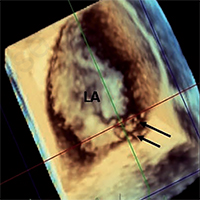Contrast transesophageal three dimensional echocardiographic imaging for patent foramen ovale: a needful role?

Submitted: March 25, 2020
Accepted: May 25, 2020
Published: October 19, 2020
Accepted: May 25, 2020
Abstract Views: 1094
PDF: 472
VIDEO 1: 413
VIDEO 2: 207
VIDEO 3: 305
VIDEO 4: 234
VIDEO 1: 413
VIDEO 2: 207
VIDEO 3: 305
VIDEO 4: 234
Publisher's note
All claims expressed in this article are solely those of the authors and do not necessarily represent those of their affiliated organizations, or those of the publisher, the editors and the reviewers. Any product that may be evaluated in this article or claim that may be made by its manufacturer is not guaranteed or endorsed by the publisher.
All claims expressed in this article are solely those of the authors and do not necessarily represent those of their affiliated organizations, or those of the publisher, the editors and the reviewers. Any product that may be evaluated in this article or claim that may be made by its manufacturer is not guaranteed or endorsed by the publisher.
Similar Articles
- Richa Tyagi, Surya Kant, Sanjeev Kumar Verma, Ram Awadh Singh Kushwaha, Santosh Kumar, Rajiv Garg, Ajay Kumar Verma, Anand Srivastava, Darshan Kumar Bajaj, Anupam Wakhlu, Anit Parihar, Akshyaya Pradhan, Riddhi Jaiswal, Spectrum of interstitial lung diseases and their association with pulmonary hypertension , Monaldi Archives for Chest Disease: Vol. 92 No. 3 (2022)
- Stefano Maffè, Paola Paffoni, Luca Bergamasco, Eleonora Prenna, Giulia Careri, Emanuela Facchini, Lara Baduena, Nicolò Franchetti Pardo, Pierfranco Dellavesa, A challenging pacemaker implantation in the presence of a giant right coronary aneurysm compressing the right atrium , Monaldi Archives for Chest Disease: Vol. 92 No. 2 (2022)
- Olga Vriz, Andrea Rossi Zadra, Abdalla Eltayeb , Fatima Asiri, Claudio Pragliola, Nader Fawzy, Domenico Galzerano, Khalid Feras, Zohair Alhalees, Abdulhalim J. Kinsara, Fadl Elmula Mohamed Fadl Elmula, Loss of engagement in controlling chronic anticoagulation therapy during Covid-19 stringency measures. A single center experience of disproportioned increase of stuck mechanical valves , Monaldi Archives for Chest Disease: Vol. 92 No. 2 (2022)
- Fulvio Cacciapuoti, Erica Vetrano, Federico Cacciapuoti, Left atrial invasion of a lung cancer: a case report , Monaldi Archives for Chest Disease: Vol. 92 No. 3 (2022)
- Vito Maurizio Parato, Germana Gizzi, Simone D'Agostino, Simona Pelliccioni, Michele Scarano, An unusual case of severe left ventricle outflow tract obstruction due to a coexistence of Takotsubo cardiomyopathy with septal hypertrophic cardiomyopathy , Monaldi Archives for Chest Disease: Vol. 92 No. 3 (2022)
- Sara Salim Ali, Imran Ahmed Qureshi, Ahmed Ayaz, Ainan Arshad, Awais Farhad, Bushra Jamil, Muhammad Rizwan Sohail, Etiology, clinical characteristics, and outcome of infective endocarditis: 10-year experience from a tertiary care center in Pakistan , Monaldi Archives for Chest Disease: Vol. 92 No. 4 (2022)
- Kevin John, Ajay Kumar Mishra, Jemimah Nayar, Jordy Mehawej, Amos Lal, Coronavirus disease 2019 and mechanical circulatory support devices: a comprehensive review , Monaldi Archives for Chest Disease: Vol. 93 No. 2 (2023)
- Domenico Galzerano, Seemi Saba , Abdullah Al Sergani, Olga Vriz, Khalil Alghalayini, Khushnooda Ramzan, Isra Elmahi, Antonio Cittadini, Giovanni Di Salvo, Valeria Pergola, Features and behavior of valvular abnormalities in adolescent and adult patients in mucopolysaccharidosis: an echocardiographic study , Monaldi Archives for Chest Disease: Vol. 91 No. 4 (2021)
- Fulvio Cacciapuoti, Ilaria Caso, Mario Crisci, Fabio Minicucci, Federico Cacciapuoti, An unexpected cause of chest pain, dyspnea and palpitations in a young patient during a post-COVID syndrome , Monaldi Archives for Chest Disease: Vol. 93 No. 3 (2023)
- Abdalla Eltayeb, Shahid Khan, Salam Dib, Ali Musthaq, Ahmed Elshaer, Abdullah Shaik, Domenico Galzerano, Bahaa Fadel, Mohamed Aladmawi, Olga Vriz, Three-dimensional printing in integrated multi-modality imaging approach for management of prosthetic valves infective endocarditis , Monaldi Archives for Chest Disease: Vol. 93 No. 4 (2023)
You may also start an advanced similarity search for this article.

 https://doi.org/10.4081/monaldi.2020.1278
https://doi.org/10.4081/monaldi.2020.1278




